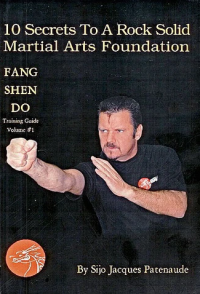Improve Speed and Reflexes
SPEED: The Holy Grail of the Martial Arts
The quest for speed has always topped the list of qualities that every martial artist wants, and indeed needs, to develop.
As Sijo Patenaude, founder of Fang Shen Do says, “Where there is flexibility, there is speed; where this is speed, there is power!”
Most martial art systems rely on the adage that “repetition is the mother of skill”, and while this is certainly true, it is the beginning, not the end, of effective speed training.
Certainly, the committed martial artist must dedicate countless hours to continually practicing and perfecting his/her techniques, but there are many types of speed. In order to train as effectively as possible, the martial artist must isolate, understand and work on developing these different speeds.
Natural Speed vs. Martial Art Speed
Natural Speed is the result of an individual’s fast-twitch muscles. We have all seen people who are blessed with natural speed. They never seem to work on it, yet the movements they perform are crisp, and blindingly fast. While these individuals certainly enjoy an advantage in their training, they still need to work on the other types of speed. While this is something that cannot be controlled, as it is a result of hereditary determination, there are many drills that can be done to enhance ones own individual speed.
The speed of a martial artist is direct and effective. It is the result of concentrated effort and continual perfection. Martial art speed incorporates all types of speed, and he/she performs their movement with economy of motion and with the least amount of wastage of movement. The martial arts speed is poetry in motion, and they are indeed a pleasure to watch. They have worked, and therefore reaped gains in the area of the Five types of Speed.
The Five Types of Speed
In Fang Shen Do Kung Fu, speed is broken down into five different categories. These speeds are explained at the beginning of the students training in order for them to understand the “why” as well as the “how” of the basic drills performed at this level. Once this concept is understood, the students are able to make much faster progress, as well as enhance their at-home training. The five types of speed are:
- Perception Speed
- Speed of Touch
- Reaction Time
- Lag time
- Speed of Motion
Perception Speed
In Fang Shen Do, perception speed is further broken down into two sub-categories: Visual and Audio. While the students concentrate on the visual, more than the audio, as it is more important to students of the martial arts, Audio training adds a new spice to the training.
Visual Speed
Visual speed is the speed in which a student is able to recognize a movement and reacts accordingly. In order to avoid confusion, it must be stated, that it is not necessary for the student to recognize the individual technique (i.e. a punch vs. a backfist), but to pick up on the fact that a movement has begun. This is of critical importance for students of self-defense, as they must identify a threat and react accordingly within a blink of an eye.
Audio Speed
Audio speed runs along the same lines as visual speed. It is the speed in which a student identifies a sound and reacts accordingly. The noise can be a shout, curse, or a tone.
Speed of Touch
Speed of touch is reacting to a movement, whereas that movement is conveyed through contact with a partner (or opponent). In Fang Shen Do, this contact is called a “reference point” or “bridge”. Speed of touch is a critical speed for martial arts that work in the grappling or trapping range. In fact, Chi Sao (sticky hands) is designed to work on this particular speed. As these practitioners are in contact with the body or limbs of their partners, there is usually not enough time to “see” the movement and then react. Their bodies have to be finely tuned, so when one part of them feels the motion, they react automatically, without the eyes becoming involved. Although this seems to be self-explanatory, many martial arts do not recognize or even work on this type of speed.
Reaction Speed
Reaction speed is perhaps the most recognized speed in the martial arts. A definition of reaction speed would be the speed in which an individual is able to react to an outside stimulus. Reaction speed is different from natural speed, because it is dependent on the other person. Most blocks and deflections that are practiced in the martial arts rely on reaction speed. Reaction speed is different than perception speed because it includes the movement, not just the identifying of a source.
Lag Time
Lag time is the speed in which a student’s brain sends a message to a limb in order to start a movement. The goal of the Fang Shen Do student is to reduce the time that it takes the brain to select a technique and react. This is accomplished by repetitive training and reducing the number of techniques that the brain must evaluate and select. Lag time is an often neglected part of the serious students training. Most Martial Arts pride themselves on how many techniques they have in their system. In Fang Shen Do, the importance is on how many techniques each individual student can perform at times of stress (with a minimal of thinking and evaluating).
Speed of Motion
Speed of motion is the speed of which a student is able to move. Unlike reaction speed, it is started and stopped by the student. An example of this brand of speed would be a punch. How fast your punch will travel from the start point to the target is an example of speed of motion. Speed of motion is closely related to natural speed, but unlike natural speed, speed of motion can be developed.
Tying It All Together
After reading the above definitions, a student must realize that they are not able to rely on one speed alone. Most techniques will rely on up to four of the individual types of speed. By understanding the different types of speed, martial artist will be able to work more efficiently towards perfecting their self-defense skills, as well as identifying weak areas in the speed arsenal and take steps to rectify them.
For the purpose of simplicity, we will examine one technique, and identify the types of speed involved. In this scenario, the examination will begin with the opponent starting an attack, and terminate when the attack has been deflected.
Movement Speed Utilized
| Attack Begins | Perception Speed |
| Martial Artist perceives attack | Lag Time |
| Beginning of Defensive movement | Reaction Speed |
| Defensive movement commences | Speed of Motion |
| Counter Attack | All speeds combined |
By breaking down the types of speed, and observing it how they all relate to the martial arts, students are able to effectively work on becoming faster. Utilizing the Fang Shen Do drills that are detailed below will further this progression.
For detailed instructions about all our Speed Drills <Click here>
Fang Shen Do Speed Drills
Quick Draw
As in most speed drills in Fang Shen Do, this one allows both partners to work on different speeds. In this manner, both partners grow, rather than one serving as a standing punching bag.
In Quick Draw, one partner stands with their hand one inch away from their chest and just off the center of the body. The other student stands with his hands beside the body. With a limited amount of movement, the partner tries to lightly strike the opponent’s chest with a finger strike. The other partner will attempt to move over to the center of the body and deflect the strike. The one partner (deflecting) will work on perception and reaction speed, whereas the other martial artist is working on their speed of motion (moving fast)
Motion Speed Drill #3
This drill allows the student to work on Speed of Touch. The students start in the contact position, back of wrists touching. Without warning, one student will retract their arm back to their chest. As soon as the other student feels the absence of pressure, he/she will react by moving forward into a strike. This drill will teach the students to react forward to the absence of pressure (natural energy load) and will greatly enhance their trapping ability.
Paper Drill
This is a drill that will greatly enhance the student’s speed and control. The student begins by suspending a piece of paper to a rope and then attaching the rope to the ceiling, or having a partner hold the paper between two fingers. The paper should be at head level, and be facing the student. The student adopts their fighting stance and throws a strike at the paper. The goal is to strike the paper without ripping it. Students can work all their strikes on this device including straight lead, finger strikes and backfists.
Speed Wrist Strike
This is a drill that allows both partners to work on different speeds. Standing in a Contact position (back of wrists touching), one partner will attempt to collapse the wrist around his/her partner’s wrist and strike them in the chest. The other partner will attempt to “read” the movement and move their wrist in order to block the movement. This will allow the partner to work on speed of touch (reacting to the partner’s movement), whereas the first partner is working on speed of motion. In addition both partners are working with energy: one attempting to read the movement, where the other to disguise it.
Speed Training with Timers
If a student is fortunate, their school will include speed training with timers into their curriculum. These timers are designed to measure reaction speed and speed of motion. These timers are invaluable for speed training as they develop a tangible measure of the individual speed and allow the student to set, and then with hard work, surpass their goals. No professional school should be without at least one timer.
Conclusion
As illustrated by this article, speed is perhaps the greatest weapon that martial artists can possess. The most powerful technique in the world won’t do the student any good if it is too slow to reach the intended target. Speed is achieved through dedicated, and more importantly, proper training. Speed is a result of years of commitment, and must happen without conscious thought. As Sijo Patenaude teaches “ Trying to move fast will only slow you down.” Fang Shen Do training recognizes this fact and drills the student right from the beginning, not only do they become faster, but they understand why they are on the road to possessing Martial Art speed.
Like this article? Go here to learn more about speed. Get immediate access to our Speed Course through the FSD App. No waiting, no shipping! Get it now!



 Fang Shen Do
Fang Shen Do